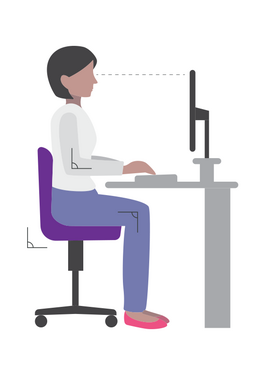
Working from home on a daily basis has become a new normal for many of us during the pandemic. Jean Hailes physiotherapist Amy Steventon offers her advice on making sure you’re perfectly positioned to do it in comfort.
Do you ever have a sharp pain when you move your neck? Does the pain spread to your back, shoulders and/or arms? Chances are that the more hunched we sit at our desks or stare chin-first into our smart phones or computers, the more likely we are to suffer from ‘tech-neck’.
That’s the new buzz term for an increasingly common condition caused by spending too much time on our devices.

COVID-19 has driven most of us from our well-designed office spaces, where the ergonomics of how we work (that is, the safety and comfort of our work areas) is taken into account. Now, we’re more likely to be sitting on a dining chair at the dinner table, where we are now at greater risk of not just tech neck, but also mid and lower back pain because of incorrect posture.
Jean Hailes physiotherapist Amy Steventon says it is possible to minimise your risks by following a step-by-step guide for setting up an ergonomically safe home workplace.

Of course, a safe home workplace isn’t just about posture. Our new working arrangements highlight the need to look after our emotional as well as our physical wellbeing. We may be working in isolation, but we can still tap into the team spirt we used to enjoy in the office by staying in regular touch with our colleagues.
“I think it’s also very important for us to enjoy some fresh air – open up those windows, take a stroll in your garden, take regular breaks from the screen,” says Ms Steventon.
Ms Steventon says it is also important to establish boundaries between our work and home life. “Structure the day so that you have a start time and a finish time,” she says.
The new work dynamic also provides women with the opportunity to incorporate pelvic floor exercises into part of their regular exercise routine, which can help improve bladder and bowel health as well as reduce the risk of prolapse.
“Pelvic floor exercises are an effective way of preventing and treating incontinence and pelvic organ prolapse,” says Ms Steventon. “With the change of your normal routine, now is a great time to make these exercises a daily habit.”
Here are Ms Steventon’s guidelines for getting yourself set up ergonomically safely to work at home.

Feet
Set your feet flat on the floor. If you feel pressure on your thighs, use a footrest to raise your feet.
Knees
Chair
Keyboard placement
Screen placement
Work techniques
If using a sit/stand workstation
If standing, adjust the height of the work surface so that your forearms are parallel to the floor.
Dual monitors
The best set-up of the monitors will depend on the time spent looking at each monitor.
Laptops
They might be convenient for people on the go, but laptops should not be used for long periods of time on their own, says Ms Steventon.
“The ideal would be to use a separate keyboard, mouse and screen with your laptop and set them all at comfortable positions,” she says.
If you must use your laptop as your screen, lift it up so that the edge of the open screen is just below your eye height. And definitely don’t use your laptop on the couch or on the coffee table.
“Make sure it is properly set up at your desk,” says Ms Steventon. “It can be elevated by using boxes, plastic tubs or books. You don’t need a fancy laptop holder.”
For more information on COVID-19 and looking after yourself during this time, visit our webpage.
All reasonable steps have been taken to ensure the information created by Jean Hailes Foundation, and published on this website is accurate as at the time of its creation.
© 2024 Jean Hailes Foundation. All rights reserved. This publication may not be reproduced in whole or in part by any means without written permission of the copyright owner. Contact: licensing@jeanhailes.org.au